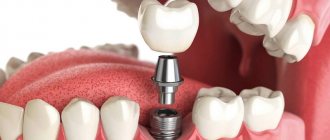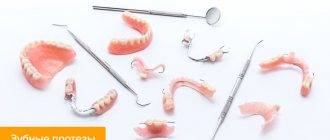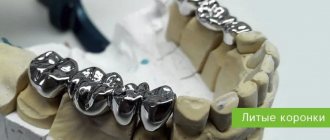The absence of even one tooth can cause both physical and psychological discomfort. That is why the simultaneous implantation procedure is very popular among patients. In a maximum of two visits, the patient solves his problem and gets a beautiful and healthy smile. As with any operation, dental implantation has its contraindications. Below we will look at all the features of the procedure and tell you for whom this method is suitable and who should resort to other procedures.
Single-stage implantation: what is it?
Instant prosthetics involves installing an implant immediately after removing a damaged tooth. This method is considered the most gentle and is recommended by doctors for those patients who do not have serious contraindications.
A thorough examination of the oral cavity should be done in advance, and if sanitation is indicated, the doctor will perform it before surgery.
Prosthetic options
Loading of an implant with a prosthesis can be:
- Instant.
A temporary crown or prosthesis is fixed to the implant immediately after its installation. In one visit, the patient receives a finished tooth. The permanent prosthesis is fixed after the artificial root has completely fused with the bone. - Deferred.
The permanent prosthesis is installed after osseointegration - after 3-5 months, the implant will be overgrown with bone tissue and take on the functions of the tooth root. Before osseointegration is completed, the gum above the implant is sutured, and the person wears a removable denture.
The treatment protocol is selected by the doctor based on the complexity of the clinical case and the condition of the bone.
Single defect
When installing an implant after the removal of one tooth, it is possible to perform prosthetics using immediate and delayed loading protocols using classic two-piece implants.
When the artificial root is immediately loaded, the abutment and temporary crown are immediately fixed. It is made of plastic or metal-plastic. The crown is made lower than the rest, removed from the bite to reduce the chewing load. After osseointegration, after 3-5 months, the crown is replaced with metal-ceramic or zirconium.
With delayed loading, a temporary crown is not placed. The gum is sutured and the implant is waited for to grow into the bone. After osseointegration, the gum is dissected, a gum former is first installed on the implant for 2 weeks, then an abutment and a crown of the patient’s choice. Until this moment, the person wears a removable butterfly denture, which is attached to adjacent teeth.
The choice of treatment regimen depends on how many teeth require replacement. It is not advisable to immediately load ones, twos, sixes, and sevens with a prosthesis. They are involved in biting and chewing, which puts stress on the artificial root. Threes, fours, and fives can be immediately loaded with a temporary crown, provided they are removed from the bite.
At the request of the patient, it is possible to install a crown immediately on implants involved in chewing. But the clinic does not provide a guarantee if the implantologist’s clear recommendations are not followed.
End defect
When several teeth are removed in the chewing area, adaptation prostheses are installed three days after the implant is inserted - a one-stage technique. The metal-plastic structure is equipped with a titanium arc, which prevents the artificial roots from loosening. The crowns are made of medical plastic, which allows for adjustments to the bite.
Prosthetics using the classical protocol is also possible. After the titanium roots have engrafted, they are loaded with crowns made from the material chosen by the patient. Unlike the previous method, it is necessary to replace each extracted tooth with an implant and install a separate crown for each, which increases treatment costs. Until the completion of the stabilization period, the patient wears a partially removable denture with clasps.
Full jaw
Prosthetics on implants solves the problem of complete edentia. Titanium roots are placed in the sockets of extracted teeth. If additional implants are needed, they are inserted into the jaw using tissue puncture. The number of implants and their placement sites are selected by the doctor after a comprehensive diagnosis of the oral cavity. The operation can be performed according to two schemes:
- classical implantation with delayed loading;
- one-stage with installation of fixed adaptive prostheses.
The classical technique is used for significant loss of bone tissue due to resorption. Before implantation of the artificial root, the missing volume is replenished by replanting bone material. For 3-5 months, while the artificial root grows into the jaw, the patient uses a removable nylon prosthesis.
During one-stage implantation, on the third day after surgery, a lightweight prosthesis made of medical plastic with a titanium arch is installed. The patient must follow the nutritional recommendations of the implantologist for a month. The food consumed should not be too hard. After a month, you can return to your usual diet. Restrictions are imposed only on too hard foods, which create increased stress on the jaw. After implantation, you should forever give up the habit of gnawing nuts, etc.
Simultaneous implantation of the anterior teeth of the jaw
The history of the express method of dental implantation
Back in the middle of the last century, Swedish professor Brenemark discovered the amazing property of titanium to organically fuse with bone tissue. This is how titanium implants appeared.
As a rule, implantation occurs in two stages: first, a titanium base of a new tooth is installed, which takes 4-6 months to grow into the bone tissue. And then a zirconium, composite or metal-ceramic prosthesis is attached.
During the period of ingrowth of the titanium implant, the hole remains empty or closed with a plastic insert. However, this type of implantation is not acceptable for all patients. This is how new, revolutionary protocols emerged that allow the installation of new teeth in one stage: All-on-4, All-on-6, basal implantation.
The main advantage of one-stage implantation is that after installing the titanium base, a temporary prosthesis is immediately placed on it, which is replaced with a permanent one after the implant has completely grown in.
This express method is often used for targeted restoration of damaged teeth in the smile area, because... In one visit, you can remove tooth fragments and immediately install a temporary crown.
Rehabilitation after surgery
To ensure that the rehabilitation period does not drag on for a long time, it is necessary to strictly follow the doctor’s recommendations, namely:
- in the first month, it is advisable to adhere to a gentle diet - do not eat hard, spicy, salty, hot or cold foods;
- Carry out hygienic brushing of teeth 15-20 minutes after each meal, using brushes that do not have hard bristles;
- in case of bleeding, apply applications with an antiseptic;
- use an irrigator together with a rinse aid (the composition is discussed with the doctor to prevent oxidation of the pins);
- for the first two weeks, avoid heavy physical activity, stop playing sports (especially martial arts);
- try to avoid stressful situations;
- for a month, avoid air travel, visits to baths, saunas and other activities that can cause changes in blood pressure;
- A complete ban is imposed on drinking alcohol and smoking.
If you strictly follow these recommendations, the period of recovery and adaptation to the prosthesis, especially the first month, will pass without incident, and the result will be a beautiful smile.
In the first year, it is recommended to visit the dentist’s office monthly for a preventive examination, and then an individual schedule is drawn up, but at least once every 5-6 months.
Indications for implantation
All medical procedures are carried out solely according to indications. Experts recommend that patients resort to simultaneous implantation for the following problems:
- restoration of the front row of teeth;
- trauma with soft tissue damage;
- severe tooth deformation;
- tooth extraction due to gum disease;
- urgent tooth restoration.
List of mandatory requirements for the procedure
During the initial examination, the doctor will assess the condition of the oral cavity for the possibility of carrying out immediate implantation. The procedure is performed only if the following requirements are met:
- Suitable volume of bone tissue.
- There is no inflammation in the area of the tooth root;
- Bone tissue without atrophic changes;
- The area of the extracted tooth without obvious tissue deformations;
- The gums are in satisfactory condition;
- The interradicular septum must be preserved.
Contraindications to one-stage dental surgery
Medical intervention should not be carried out if the patient has contraindications for this, which are divided into the following types:
- absolute (operation excluded);
- local (depending on the condition of the jaw);
- relative (the decision about the operation is made by the doctor).
The doctor eliminates all risks at the first examination and carefully examines the patient’s medical history. During the conversation, clarifying questions are asked to provide a complete picture of past and chronic diseases.
Let's consider absolute contraindications, in which simultaneous implantation is completely excluded:
- Allergy to the administration of anesthesia.
- Various blood diseases.
- All degrees of diabetes.
- Weak immunity.
- The bone tissue has undergone atrophic changes.
- Connective tissue does not recover quickly enough.
- Chewing muscles are in strong tone.
- Tuberculosis.
- The endocrine system has pathologies.
- Venereal diseases.
- Tumors of a malignant nature.
- Presence of mental illness.
- HIV infection.
Relative contraindications
These contraindications are only an obstacle to immediate implantation. The doctor decides how risky the procedure is.
- The gums are subject to inflammation.
- Some teeth require sanitation.
- The bite has pathological disorders.
- Presence of arthrosis changes.
- Tobacco use.
- Arthritis.
- Alcohol and drug addictions.
- Any trimester of pregnancy.
- The oral cavity is in unsatisfactory hygienic condition.
- Marginal periodontitis.
Local contraindications
- There is not enough bone tissue.
- The jaw arch is not dense enough and its structure is damaged.
- The short distance to the sinus makes the operation labor-intensive.
Temporary factors under which the procedure is possible
The doctor gives permission to perform the operation after the patient resolves the issue with the following factors:
- Chemotherapy.
- The period of rehabilitation after a somatic illness;
- Exacerbation of chronic and other diseases;
- Pregnancy.
After a course of chemotherapy, you should wait at least a year and only after this period can you have surgery. Let's not hide it - there is always a risk of implant rejection and the doctor will not give you a 100% guarantee, but the result is quite justified: the artificial tooth will look like a real one.
Despite the rather long list of contraindications, some of them can be corrected and treated. In addition, the procedure can also be performed by people of retirement age, which makes this procedure accessible and popular among patients of dental clinics around the world.
Contraindications
It is impossible to carry out instant implantation in 1 day:
- in the presence of acute or chronic gum or periodontal diseases;
- if there are severe diseases of internal organs, blood clotting disorders;
- in the presence of malignant neoplasms;
- during acute infections;
- in all trimesters of pregnancy and during lactation;
- if the patient has a job with an increased risk of injury or is involved in highly traumatic sports.
Advantages of one-stage dental implantation
Here we will look at the benefits of the procedure and talk about why patients choose it and doctors recommend it:
- the procedure takes place in a short time - a maximum of two days;
- the health of neighboring teeth is preserved;
- less manipulation than with classical implantation;
- gum formation begins immediately after the installation of the abutment and crown;
- pronounced aesthetic effect - the artificial tooth looks like a natural one.
It is obvious that one-stage implantation is significantly superior to traditional (classical) implantation, because it is not only more affordable, but also less traumatic. You don’t have to go to the clinic for a long time, just 2 days and your smile will be beautiful and natural.
Preparation for implantation
Simultaneous dental implantation is a complex procedure that requires preliminary diagnosis of the condition of the oral cavity for dental caries and the presence of various inflammatory diseases. Implantation can be started only after complete treatment. To obtain reliable information about the height or level of the bone tissue into which the implant is planned to be implanted, it is necessary to take an X-ray of the teeth. If it turns out that there is not enough bone tissue to perform the operation, the doctor will first augment it.
How much does express implantation cost at the Lotus Dent dental clinic?
The price of one-stage implantation depends on a number of factors: the type of technique, brand of implant, the need for additional manipulations (bone grafting or gum grafting). Doctors will be able to name the exact amount only after diagnosis.
If you contact our clinic, you can be sure that the treatment will be carried out by professionals in their field. Our doctors strive to create the optimal treatment plan for each patient, taking into account his clinical case and financial capabilities. You can make an appointment at the Lotus Dent dental clinic by calling the phone number listed on the website.
Stages of one-stage implantation
Fear of the dentist is a fairly common problem, despite the fact that modern methods and materials can significantly reduce pain during treatment. The worries will not be so strong if you initially know all the stages of the procedure and see that there is nothing to fear:
- Before the operation, a consultation is always carried out with a detailed diagnosis of the patient’s condition.
- A CT scan of the jaw is performed.
- A decision is made on the advisability of the operation.
- The doctor makes a 3D simulation of the operation.
- The patient is given local anesthesia.
- Complete removal of the deformed tooth is performed;
- Using a special drill, a hole is drilled in the bone tissue of the jaw.
- The hole is expanded to the optimal diameter with a special tool.
- The implant is implanted through the root socket: the element is screwed into the jaw.
- Next, the abutment is fixed to the implant.
- A temporary composite crown is installed.
A temporary crown should be worn until the implant is completely healed. On average no more than six months. Then a permanent crown is installed from durable, abrasion-resistant materials: metal ceramics or zirconium dioxide.
Fast planned installation of implants using navigation templates
The use of templates during implantation allows you to reduce the time for implantation. The video below describes the installation of mini-implants, but the approach is similar to classical implantation.
What are surgical guides? These are plastic structures that are attached to the site where the operation will be performed. Guide holes are pre-drilled on them; special cutters with depth limiters are used to prepare the hole for installing implants.
A few days before the operation, the patient is examined and a three-dimensional study is carried out, the data obtained is transferred to a computer program that creates a model for installing artificial tooth roots. In the program, the doctor determines the optimal location for installing the implant, calculates the angle and depth of insertion. Afterwards, an implantation project is developed, based on which an implantation surgical template is printed on a 3D printer.
Using this template, the surgeon spends no more than 10 minutes to install one implant, while the bone tissue is prepared with minimal trauma. The risks of complications are almost completely eliminated. Read more about the technology here.
Recovery postoperative period
After the operation, the recovery period begins, the person has solved his problem and now there is an implant instead of a damaged tooth. How to care for it and what should you be wary of on the doctor’s recommendation until the tooth finally begins to feel like your own?
For the first few days, the patient will experience slight swelling, which will cause discomfort. This is normal because surgery was performed. It is worth avoiding excessive chewing loads during this period and carefully monitoring oral hygiene using special antiseptics. During the first month, the discomfort goes away, and the patient forgets that he has an implant installed.
Review statistics among specialists and patients
The one-stage prosthetics method began to be used in Russia relatively recently, while in Europe such services have been provided for several years. Analyzing world statistics, you can see that this method has collected a large number of positive reviews and enjoys well-deserved trust among both doctors and patients. The problem of a missing tooth is solved in record time.
Single-stage implantation also perfectly solves the aesthetic component of the problem: there are patients who do not like the look of their own teeth. They delay visiting the dentist and go without a tooth for a long time, not deciding on implantation. In addition, many people think that implantation takes a long time and are unable to find a place for the procedure due to their busy work schedule. However, the procedure is performed quickly and the installed tooth will look aesthetically pleasing and natural. Negative reviews can only be found regarding dissatisfaction with the price: the procedure is not budget-friendly and not everyone can afford it.
Price
The technique of one-stage implantation requires the use of high-quality materials and modern equipment. In addition, the highly qualified implantologist is very important. The total cost of the procedure consists of consumables, the level of the doctor and the clinic. If the clinic has its own dental laboratory, the cost of the implant will be significantly lower. The average price for a turnkey installation is 45 thousand rubles. The service life of implants reaches 25 years, provided that high-quality materials are selected and the procedure protocol is strictly followed. The best implants are those made in Sweden, Israel and the USA.









